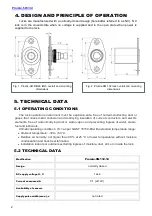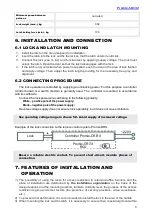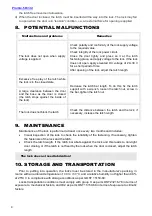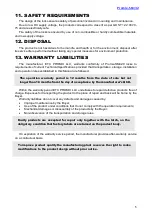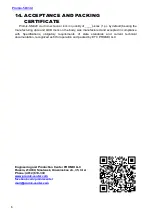
4
The lock does not need lubrication!
the latch free movement allowance.
4) When the door is closed, the latch must be inserted all the way into the lock. The lock may fail
to open when the door is in “tension” condition, i.e., an external force for opening is applied.
8.
POTENTIAL MALFUNCTIONS
Malfunctions and problems
Remedies
The lock does not open when supply
voltage is applied
Check polarity and conformity of the lock supply voltage
to the required value.
Check integrity of the lock power circuit.
Close the door tightly and press on it at the latch
fastening place, and apply voltage to the lock. If the lock
does not open, apply elevated DC voltage of 20
–30 V
for a short period of time.
After opening of the lock, adjust the latch length.
Excessive free play of the latch while
the lock is in the closed state
Decrease the latch bar length. To do this, fix the latch
support with a wrench, loosen the latch nut, screw in
the bar, tighten the latch nut.
A large clearance between the door
and the base as the door is closed
(the latch stops against the inside of
the lock)
The lock does not block the latch
Check the distance between the latch and the lock; if
necessary, increase the latch length.
9.
MAINTENANCE
Maintenance of the lock is performed at least once every two months and includes:
Visual inspection of the lock to check the reliability of the fastening. If necessary, tighten
the fasteners of the lock and the latch.
Check the latch length. If the latch bar abuts against the lock and this leads to non-tight
door closing, or if the latch is not fixed by the lock when the door is closed, adjust the latch
length.
10.
STORAGE AND TRANSPORTATION
Prior to putting into operation, the locks must be stored in the manufacturer’s packing, in
rooms with an ambient temperature
of -30 to +50
°С
and a relative humidity not higher than 98 %
at 25ºС С in compliance with storage conditions as per GOST 15150-69.
Locks transportation conditions must comply with group C as per GOST 23216-78 in terms of
exposure to mechanical factors, and Ж2 as per GOST 15150-69 in terms of exposure to climatic
factors.


